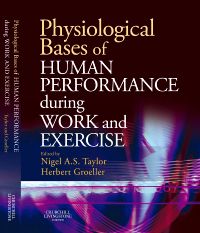Physiological Bases of Human Performance During Work and Exercise, 1st Edition
Authors :
Nigel A. S. Taylor & Herbert Groeller
Physiological Bases of Human Performance during Work and Exercise is a high-level physiology text for advanced students, researchers and practitioners in the fields of human physiology, exercise science and applied physiology. Eighty internationally
...view more
Physiological Bases of Human Performance during Work and Exercise is a high-level physiology text for advanced students, researchers and practitioners in the fields of human physiology, exercise science and applied physiology. Eighty internationally recognised scientists from sixteen countries have written chapters within six areas: Physiological performance limits and human adaptation; The physiological bases of gender differences in performance; Age and human performance; Performance under environmental extremes; Exercise and health interactions; and Optimising performance through supplementation. Each section contains state-of-the-art reviews of the scientific literature. To stimulate critical thinking, there are thirteen debates and discussions that focus on some of the controversial topics that exist across these disciplines.
Physiological Bases of Human Performance during Work and Exercise is a high-level physiology text for advanced students, researchers and practitioners in the fields of human physiology, exercise science and applied physiology. Eighty internationally recognised scientists from sixteen countries have written chapters within six areas: Physiological performance limits and human adaptation; The physiological bases of gender differences in performance; Age and human performance; Performance under environmental extremes; Exercise and health interactions; and Optimising performance through supplementation. Each section contains state-of-the-art reviews of the scientific literature. To stimulate critical thinking, there are thirteen debates and discussions that focus on some of the controversial topics that exist across these disciplines.
Key Features
• Covers latest research• Fully referenced• Internationally known authors/experts• Presenting critical debates
Author Information
By Nigel A. S. Taylor, PhD, Human Performance Laboratories, School of Health Sciences, University of Wollongong, Australia and Herbert Groeller, PhD, Human Performance Laboratories, School of Health Sciences, University of Wollongong, Australia
| ISBN Number | 9780443102714 |
|---|---|
| Main Author | By Nigel A. S. Taylor, PhD and Herbert Groeller, PhD |
| Copyright Year | 2008 |
| Edition Number | 1 |
| Format | Book |
| Trim | Other |
| Illustrations | Approx. 160 illustrations |
| Imprint | Churchill Livingstone |
| Page Count | 608 |
| Publication Date | 11 Aug 2008 |
| Stock Status | IN STOCK - This may take up to 5 business days to ship |
List of contributors. PrefaceSection 1: Limitations and adaptations. Section Introduction - Human adaptation (Roy Shephard).Chapter 1 - Cardiovascular responses to exercise and limitations to human performance )Michael Tschakovsky and Kyra Pyke). Chapter 2 - Pulmonary responses to exercise and limitations to human performance (MIchael Stickland, Markus Amman, Keisho Katayama and Jerome Dempsey). Chapter 3 - Cardiovascular and pulmonary adaptations to endurance training (Daniel Green, Louise Naylor, Keith George, Jerome Dempsey, Michael Stickland and Keisho Katayama). Chapter 4 - Neuromuscular adaptations to exercise (Paavo Komi and Caroline Nicol). Chapter 5 - Central and neuromuscular fatigue (Janet Taylor, Paavo Komi, and Caroline Nicol). Chapter 6 - Cellular mechanisms of skeletal muscle fatigue (David Allen, Graham Lamb and Hakan Westerblad). Chapter 7 - Performance limitations due to substrate availability (Mark Hargreaves). Chapter 8 - Genetics and human performance: natural selection and genetic modification (Geoffrey Goldspink and Christiana Velloso). Chapter 9 - Detraining, bed rest and adaptation to microgravity (Marco Narici, Claire Stewart and Pietro di Prampero). Chapter 10 - Topical debates. 10.1 Maximal exercise: is it limited centrally or peripherally? (Peter Wagner and Niels Secher). 10.2 Human performance and maximal aerobic power (Timothy Noakes and Bjorn Ekblom). 10.3 The anaerobic threshold: fact or misinterpretation (Mike Lindinger and Brian Whipp).Section 2: Gender differences. Section introduction - Our limits of physiological knowledge: the legacy of male-based physiology (Sarah Nunneley).Chapter 11 - Exercise, work and stress in adolescent and adult women (Denise Smith, Patricia Fehling and Jeff Segrave). Chapter 12 - Human performance in the pregnant woman: foetal and materanl considerations (Michelle Motola). Chapter 13 - Physiological bases of health-enhancing physical activity for post-menopausal women (Katriina Kukkonen-Harjula and Tuula-Maria Asikainen). Chapter 14 - Topical debates. 14.1 Physically demanding trades: can women tolerate heavy workloads? (Peter McLennan, Herbert Groeller, Denis Smith and Nigel Taylor). 14.2 Are women narrowing the gender gap in elite sport performance? (Alan Nevill and Greg Whyte).Section 3: Age. Section introduction - Physical activity in the 21st century: challenges for young and old (Pietro di Prampero).Chapter 15 - Physical performance in prepubescent and adolescent males and females: limits, benefits and problems (Thomas Rowland). Chapter 16 - The physiology of ageing in active and sedentary humans (Herbert Groeller). Chapter 17 - Topical debates. 17.1 Thirty minutes of incidental exercise is adequate exercise prescription (Hidde P. van der Ploeg and Adrian Bauman). 17.2 Exercise and aageing: can the biological clock be stopped? (David Proctor and Michael Joyner).Section 4: Environmental extremes. Section introduction - Human performance from the ocean floor to deep space (Nigel Taylor).Chapter 18 - Concepts in physiological regulation: a thermoregularatory perspective (Jurgen Werner, Igor Mekjavic and Nigel Taylor). Chapter 19 - The physiology of acute heat exposure, with implications for human performance (Nigel Taylor, Narihiko Kondo and Larry Kenney). Chapter 20 - The physiology of acute cold exposure, with particular reference to human performance in the cold (Nigel Taylor, Igor Mekjavic and Michael Tipton). Chapter 21 - Physiological adaptation to hot and cold environments (Michael Tipton, Kent Pandolf, Michael Sawka, Jurgen Werner and Nigel Taylor). Chapter 22 - The physiology of water immersion (John Krasney and David Pendergast). Chapter 23 - Diving physiology: free diving, breathing apparatus, saturation diving (James Morrison and John Clarke). Chapter 24 - Altitude physiology: the impact of hypoxia on human performance (Claudio Marconi and Paolo Cerretelli). Chapter 25 - Human adaptation to altitude and hypoxia: ethnic differences, chronic adaptation and altitude training (Carsten Lundby, Claudio Marconi, Paolo Cerretelli and Benjamin Levine). Chapter 26 - Physiological considerations of human performance in space (Helmut Hinghofer-Szalkay and Ronald White). Chapter 27 - Topical debates. 27.1 Do humans have selective brain cooling? (Lars Nybo and Matthew White). 27.2 A critical core temperature and the significance of absolute work rate (Jose Gonzalez-Alonso, Ola Eiken and Igor Mekjavic). 27.3 Do training-induced plasma volume changes improve athletic performance? (Hiroshi Nose and Scott Montain).Section 5: Exercise Interactions. Section introduction - Does exercise have a role in the treatment of chronic disease? (Herbert Groeller).Chapter 28 - Physiological penalties of the sedentary lifestyle (Manu Chakravarthy). Chapter 29 - Overreaching and overtraining (Laurel MacKinnon, Shona Halson, Sue Hooper and Asker Jeudendrup). Chapter 30 - Exercise and disease states (Arthur Jenkins and Guy Plasqui). Chapter 31 - Topical debates. 31.1 It is not economically viable to address the penalties of sedentary behaviour through primary prevention strategies (Roy Shephard).Section 6: Optimising performance through supplementation. Section introduction - Ethical considerations of human performance optimisation (Andy Miah).Chapter 32 - Optimising and enhancing human performance through nutrition (Louise Burke, Bente Kiens and Kevin Tipton). Chapter 33 - Fluid, electrolyte and carbohydrate requirements for exercise (Scott Montain and Samuel Cheuvront). Chapter 34 - Topical debates. 34.1 Sports supplements debate: a risky practice that produces expensive urine, or legitimate performance boosts can be found in a packet or bottle? (Louise Burke). 34.2 Current drinking guidelines are not evidence-based (Timothy Noakes).Index.
Write Your Own Review
Only registered users can write reviews. Please sign in or create an account
product
https://www.us.elsevierhealth.com/physiological-bases-of-human-performance-during-work-and-exercise-9780443102714.html
4683
Physiological Bases of Human Performance During Work and Exercise
https://www.us.elsevierhealth.com/media/catalog/product/9/7/9780443102714.jpg
64.76
80.95
USD
InStock
/Health Professions/Athletic Training
/Books
/Winter Sale - 20% Off Select Books and eBooks
108
5255039
5924653
1
3
6
5145120
Physiological Bases of Human Performance during Work and Exercise is a high-level physiology text for advanced students, researchers and practitioners in the fields of human physiology, exercise science and applied physiology. Eighty internationally recognised scientists from sixteen countries have written chapters within six areas: Physiological performance limits and human adaptation; The physiological bases of gender differences in performance; Age and human performance; Performance under environmental extremes; Exercise and health interactions; and Optimising performance through supplementation. Each section contains state-of-the-art reviews of the scientific literature. To stimulate critical thinking, there are thirteen debates and discussions that focus on some of the controversial topics that exist across these disciplines. Physiological Bases of Human Performance during Work and Exercise is a high-level physiology text for advanced students, researchers and practitioners in the fields of human physiology, exercise science and applied physiology. Eighty internationally recognised scientists from sixteen countries have written chapters within six areas: Physiological performance limits and human adaptation; The physiological bases of gender differences in performance; Age and human performance; Performance under environmental extremes; Exercise and health interactions; and Optimising performance through supplementation. Each section contains state-of-the-art reviews of the scientific literature. To stimulate critical thinking, there are thirteen debates and discussions that focus on some of the controversial topics that exist across these disciplines.
0
0
add-to-cart
9780443102714
2011 and earlier
Professional
By Nigel A. S. Taylor, PhD and Herbert Groeller, PhD
2008
1
Book
Other
Approx. 160 illustrations
Churchill Livingstone
608
Aug 11, 2008
IN STOCK - This may take up to 5 business days to ship
By <STRONG>Nigel A. S. Taylor</STRONG>, PhD, Human Performance Laboratories, School of Health Sciences, University of Wollongong, Australia and <STRONG>Herbert Groeller</STRONG>, PhD, Human Performance Laboratories, School of Health Sciences, University of Wollongong, Australia
Books
Books
No
No
No
No
Please Select
Please Select
Please Select
Related Products
-
20% OFF
 Book
Book
-
20% OFF
 Flash Cards
Flash Cards
-
20% OFF
 Book
Nolte's The Human Brain in Photographs and Diagrams
Book
Nolte's The Human Brain in Photographs and DiagramsTodd W. Vanderah
Jan 2019
Special Price $51.19 $63.99 -
20% OFF
 Book
Book
-
20% OFF
 Book
Book
-
20% OFF
 Flash Cards
Flash Cards
-
20% OFF
 Flash Cards
Flash Cards
-
20% OFF
 Book
Book
-
20% OFF
 Online Resource
Netter's Dissection Video Modules (Retail Access Card)
Online Resource
Netter's Dissection Video Modules (Retail Access Card)University of North Carolina Chapel Hill and Frank H. Netter
Oct 2015
Special Price $144.79 $180.99 -
20% OFF
 Book
Book




